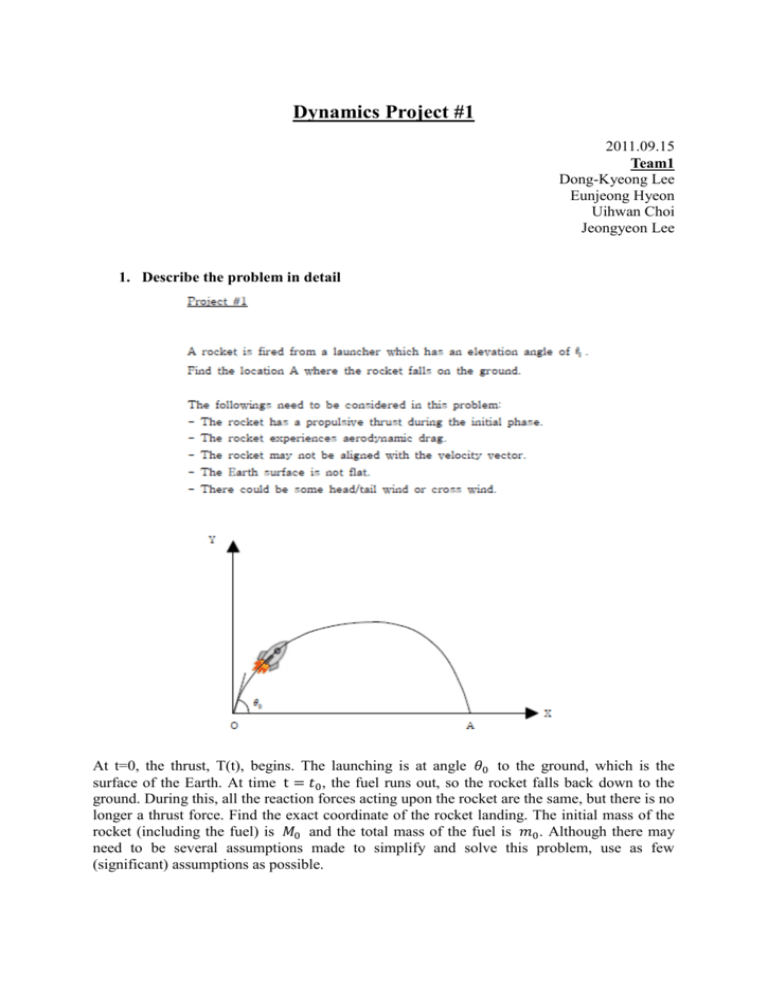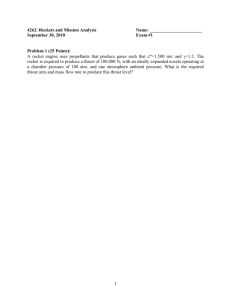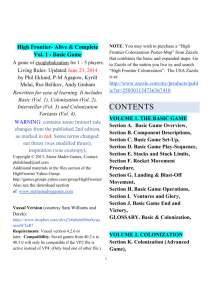Dynamics Project #1
advertisement

Dynamics Project #1
2011.09.15
Team1
Dong-Kyeong Lee
Eunjeong Hyeon
Uihwan Choi
Jeongyeon Lee
1. Describe the problem in detail
At t=0, the thrust, T(t), begins. The launching is at angle 𝜃0 to the ground, which is the
surface of the Earth. At time t = 𝑡0 , the fuel runs out, so the rocket falls back down to the
ground. During this, all the reaction forces acting upon the rocket are the same, but there is no
longer a thrust force. Find the exact coordinate of the rocket landing. The initial mass of the
rocket (including the fuel) is 𝑀0 and the total mass of the fuel is 𝑚0 . Although there may
need to be several assumptions made to simplify and solve this problem, use as few
(significant) assumptions as possible.
2. Assumptions to simplify the problem
(1) Assume that the surface of the Earth is flat, not round
(2) Ignore air friction and drag
(3) The gravitational potential energy is constant throughout the entire surface of the Earth
and it does not change with differences in altitude
(4) Assume that all of the fuel is used up instantaneously at the start of the launch
(5) Earth does not undergo rotation
(6) There is no centripetal force
(7) The initial launch velocity is 𝑣0
(8) There is no drag, lift and angle of attack on the rocket (no relation to flight mechanics)
(9) The rocket does not escape the atmosphere of Earth. Therefore the time of fuel
consumption does not exceed the minimum period needed for the rocket to go out into space
and the rocket does not have enough speed to perform satellite motion
<Step 0> Class Contents
1. Coordinate systems
Use these to specify the position and the altitude of the rocket at a given time.
3 coordinates are required to specifically pinpoint the positions of objects in a 3D
problem.
The coordinate system most often used is Cartesian coordinates.
Other alternatives available are Polar, cylindrical, spherical coordinates.
Constraints: degrees of freedom -> The minimum number of variables required to
describe the motion of an object (translation, rotation, etc)
e.g. 3D sphere: 3 variables
sphere surface: 2 variables
The motion of the rocket can be expressed as the following:
This can be expressed in terms of x(t) and z(t)
We need to write equations of motion for x, z
2. How to calculate x(t), z(t)
You need equations of motion
F = ma
Differential Equation:
F = max = mẍ
{ x
Fz = maz = mz̈
ẍ = f1 (x, ẋ , z, ż )
z̈ = f1 (x, ẋ , z, ż )
3. Integration
Second order differential equation
ẍ = f(x, ẋ )
x1 = x
x2 = ẋ
ẋ 1 = x2
ẋ 2 = f(x1 , x2 )
ẋ 1
x2
[ ]=[
]
ẋ 2
f(x1 , x2 )
ẋ = f(x)
For a given x(0):
x(∆t) = x(0) + f(x0 )∆t
However this gives a lot of errors
Therefore instead of Euler Method, use Runge-Kutta method instead, which involves
4th order integration
Euler Method: Solve ordinary differential equations numerically
Runge-Kutta: Solve ordinary differential equations by approximation
<Step 1> Use all assumptions
𝑥: 𝑥𝑓𝑖𝑛𝑎𝑙 = (𝑣0 𝑐𝑜𝑠𝜃0 )𝑡𝑡𝑜𝑡𝑎𝑙
{
1
ℎ: 0 = (𝑣0 𝑠𝑖𝑛𝜃0 )𝑡𝑡𝑜𝑡𝑎𝑙 − 𝑔𝑡𝑡𝑜𝑡𝑎𝑙 2
2
𝑥final =
2𝑣0 𝑠𝑖𝑛𝜃𝑐𝑜𝑠𝜃
𝑔
<Step 2> Assumption (1) Considering the curvature of the Earth
First we need to choose a coordinate system to represent the positions. The first most likely
choice is the Cartesian plane. However as Earth is round, the ground x is round, making it
difficult to present with the Cartesian coordinate system. Therefore we chose to use the Polar
coordinate system (2 dimensional for now)
By using the above mathematical method, we can determine and set both the landing position
and the trajectory of the rocket in motion. However we are assuming that the Earth is a
perfect sphere. Realistically, this is not so. However it is difficult to create a more realistic
elliptical shaped model.
<Step 3> Assumption (4) Fuel usage of the rocket
The rocket does not use up all the fuel instantaneously at the initial stage of the launching.
Instead it uses up fuel over time and eventually there is no more thrust force, so the rocket
experiences free fall motion.
One experimental basis for this characteristic trait can be correlated to KSLV-1.
After takeoff, the rocket goes up vertically for 20 seconds. When it reaches the 900m altitude,
the rocket has a kick-turn, which is the tilting of its body to fly in the direction of the South.
After 215 seconds, fairing is dislodged from the body. After 228 seconds, the first stage
engine is separated from the second state engine..
Flight Order
Time(sec) Altitude(km) Distance(km)
① take off
0
0.1
0
② exceed the speed of sound (Mach 1)
54
7.2
0.8
③ fairing separation
215
177
245
④stop first stage engine
229
193
303
⑤ first stage engine separation
232
196
316
KSLV-I
.
KSLV-I component 1 largely consists of 5 sections. The component 2 is also made
up of 5 sections
Details
Values
Total weight
140t
Weight of fuel
130t
Total height
33m
Diameter
2.9m
First stage (liquid engine) : 170 t
fuel and oxidant : Kerosene + LOX
Thrust
Supply system : turbo pump type
Second stage (solid kick-motor) : 8t
<Step 4> Free fall
For any bodies with Reynolds number above the critical Reynolds number, the following
equation of motion applies:
dv 1
m = ρCD Av 2 − mg
dt 2
Assuming that the object is falling from rest and there is no change in air density with altitude,
the solution is:
gt
v(t) = −v∞ tanh( )
v∞
2mg
Where terminal velocity, v∞ = √ρC
DA
To find the vertical position, we can integrate v with respect to time. (In terms of Cartesian
coordinate system)
2
v∞
gt
y = y0 −
lncosh( )
g
v∞
Another equation of motion available is:
3. Questions
(1) How should we express the system in 3D coordinates?
(2) Is there a method to express the rotation of Earth through mathematical expressions?
Would the rotation be very significant?
(3) Is there a method to find the average thrust output value over a set period of time? For
example, the thrust amount fluctuates. Therefore is there an appropriate approximation for the
values? Also when I looked at some of the thrust output graphs of actual rockets, it was a
slightly fluctuating straight graph that dies off exponentially. Is there a method to estimate
that as well?
(4) Is it necessary to find the effects of the cloud? There are too many variations concerning
them.
(5) How do I determine the orientation of the rocket during its flight? As it is not a round
object, its orientation will affect the drag, thrust direction and flight characteristics
significantly.
(6) Are the factors you mentioned the only significant sources of error?
(7) It is difficult to understand how and when Euler Method and Runge-Kutta Method are
used.










